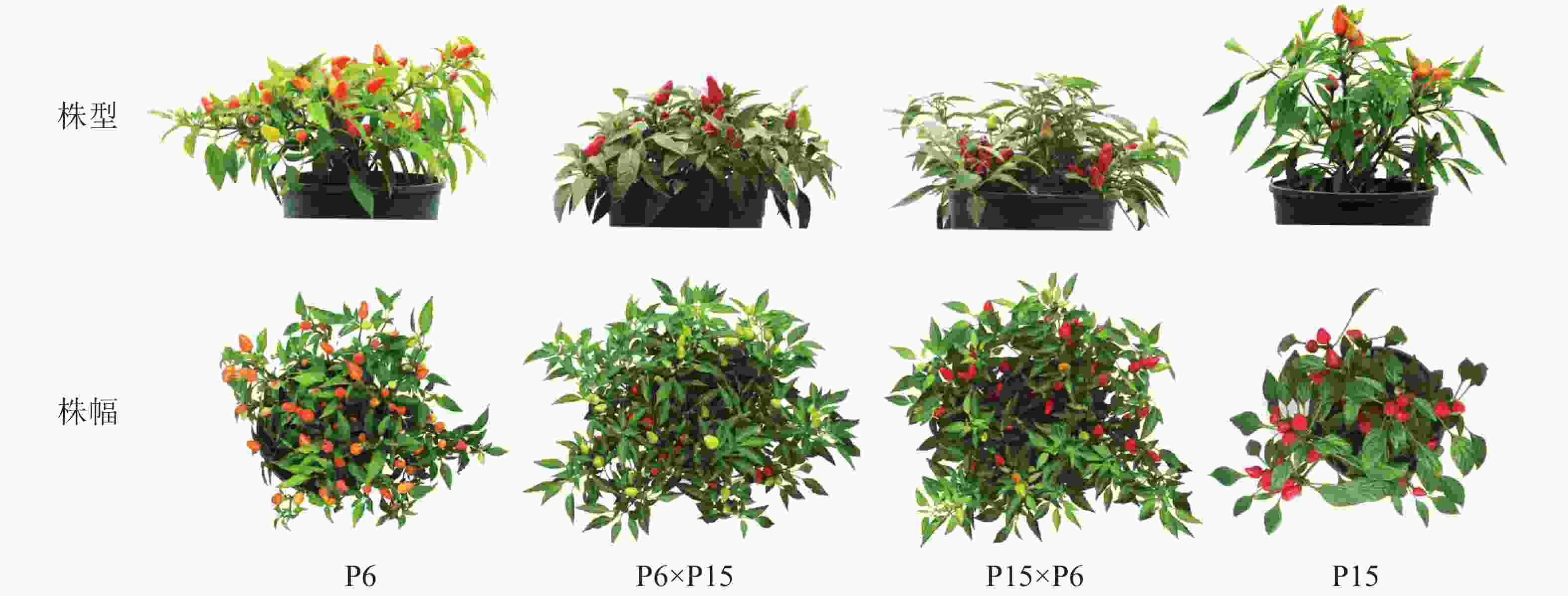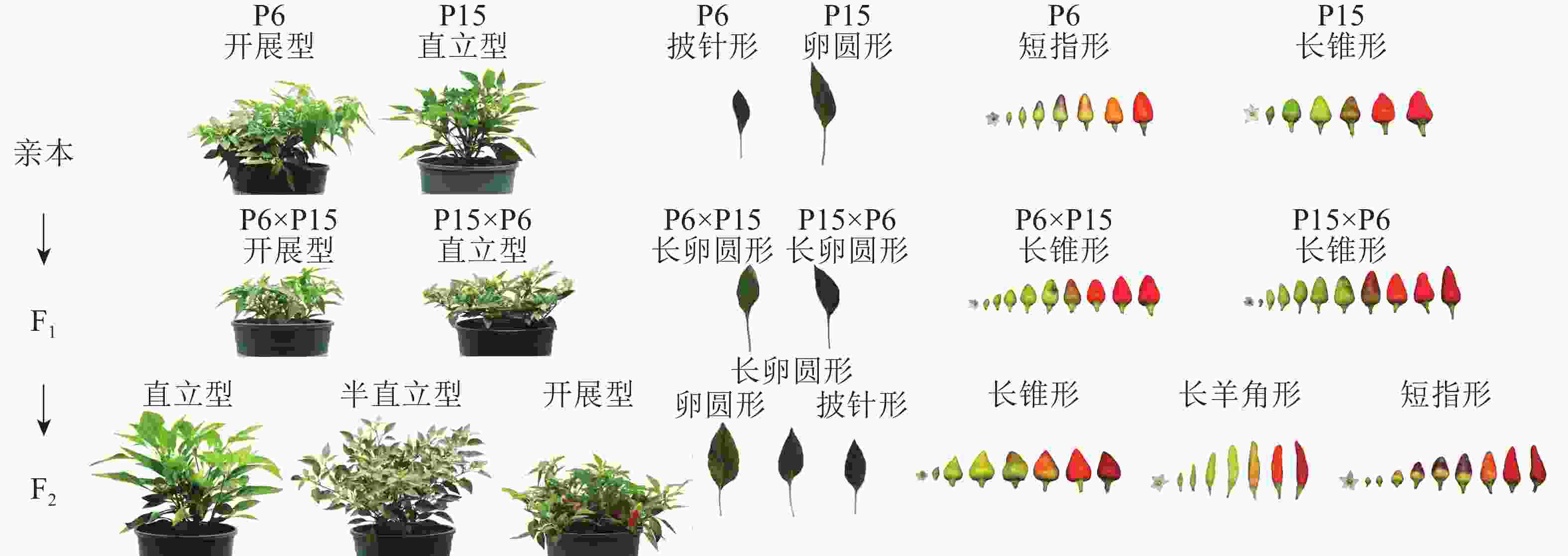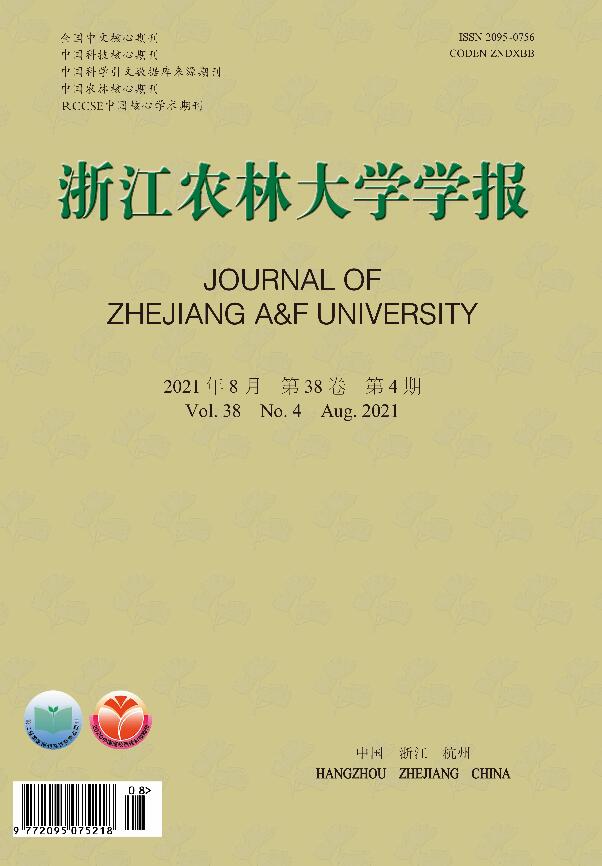-
观赏辣椒为辣椒属Capsicum中一类主要作为观赏用途的特殊类型,通常指那些果形奇特、果色斑斓、株型紧凑、适合盆栽的辣椒品种,既可用于日常食用,又可作园艺用途、花坛布置与家居装饰,具有良好的开发应用前景[1]。多年来,国外育种者开始有针对性地对观赏辣椒的表型性状进行遗传改良,培育出了很多具有新奇性状的新品种。ASMA等[2]用杂交方式培育了营养价值高出普通辣椒12%且适合观赏和盆栽种植的观赏辣椒品种;METTUPALAYAM等[3]在研究辣椒果实提取物对糖尿病治疗疗效的过程中,发现多个观赏辣椒品种果实提取物对糖尿病患者的疗效要优于普通辣椒果实;MANDARSARI等[4]发现:观赏辣椒的遗传特性明显优于普通辣椒,对高温干旱环境的适应能力更强。中国学者对观赏辣椒也进行了专门研究,如郭咏梅等[5]以3个紫色观赏辣椒品种的果实为试材,进行花青素的提取工艺优化以及pH示差法测定条件的确定,并进一步证实观赏辣椒果实花青素含量与色差值存在显著的相关性;王云梅等[6]通过杂交方式育成了6个适合凉山地区种植,耐寒且极具观赏价值的观赏辣椒品种。杂交育种是当前观赏辣椒新品种培育中的常用方法。目前,针对普通辣椒果实品质与辣椒素含量遗传规律的研究较多,对于观赏辣椒观赏特性、营养特性和环境适应性方面的研究也见报道,但针对观赏辣椒果实着生方式、叶形与株型以及辣椒花器等性状的遗传规律研究还未见报道。果实着生方式、叶形与株型等都是决定观赏价值的重要特性,了解其遗传规律将极大地提高育种效率。本研究以直立型簇生椒与开展型单生椒为材料,配置正反交组合及构建F2群体,测量和统计亲本、F1和F2的叶形、果实着生方式、株型性状,研究其遗传规律,为后续新品种选育提供理论基础。
HTML
-
本研究选用从美国进口单生椒Capsicum annuum ‘Salsa Deep Orange’的高代自交系P6,簇生椒C. annuum ‘Salsa XP Red’的高代自交系P15,杂交获得F1,F1自交获得F2。P6最显著的特点为开展型株型,果实着生方式单生,披针形叶片,青熟果颜色黄色;P15最显著的特点为直立型株型,果实着生方式簇生,卵圆形叶片,青熟果颜色绿色(表1)。
材料 青熟果色 果形 果实着生状态 叶形 分枝类型 株型 P6 乳黄 短指形 单生 披针形 无限生长 开展 P15 绿 长锥形 簇生 卵圆形 有限生长 直立 P6×P15 绿 长锥形 单生 长卵圆 无限生长 半直立 P15×P6 绿 长锥形 单生 长卵圆 无限生长 半直立 Table 1. Main characteristics of ornamental pepper parents and their reciprocal cross combinations
-
试验在浙江农林大学实验基地的塑料温室内进行。试验材料于2019年8月12日播种,9月13日田间定植,10−12月观察记录。亲本定植各20株,正反交F1各定植20株,正反交F2群体分别定植150株。株行距45 cm×50 cm,采取常规田间管理。材料进入果实成熟期后调查其表型性状。
-
依据《辣椒种质资源描述规范和数据标准》[7]选定13个农艺性状进行统计分析,其中品质性状4个,分别为果实着生方式、分枝类型、叶形、株型;数量性状9个,分别为株高、株幅、侧枝数、分枝级数、单株结果数、叶长、叶宽、叶柄长及单节叶腋着生花数;数量性状使用美耐特游标卡尺测量,每个指标设置10次重复。使用Canon EOS30D单反相机拍摄记录性状。使用SPSS和Excel软件对测量所得数据进行统计分析、相关性分析、方差分析、性状变异频率和卡方检验分析。变异系数(VC)计算方法参考段晓铨[8]方法: VC=DS/NM×100%,DS为标准偏差,NM是平均值;中亲优势=(F1−MP)/MP×100%,超亲优势=(F1−HP)/HP×100%,F1为杂交组合F1代表型,Mp与Hp为双亲表型性状的均值与高值亲本的表型。
1.1. 试验材料
1.2. 试验方法
1.3. 性状调查
-
由表2可知:P6和P15在单株结果数、叶长、叶宽、叶柄长、株高、侧枝数、分枝级数、单节叶腋着生花数等指标均存在显著差异(P<0.05),P6×P15与P15×P6在叶长、株幅、侧枝数、分枝级数4个性状上存在显著差异(P<0.05),正反交的F2代群体在分枝级数性状上表现出显著差异(P<0.05)。
世代 株高/cm 株幅/cm 侧枝数/个 分枝级数/级 单株结果数/个 叶长/mm 叶宽/mm 叶柄长/mm 单节叶腋着
生花数/朵P6 21.64±1.61 c 41.27±2.35 cd 8.50±1.72 b 7.40±1.17 a 26.10±4.84 d 63.94±1.66 c 23.57±0.95 b 34.11±1.08 c 4.00±1.49 d P15 24.90±1.79 b 38.93±3.12 d 3.30±0.82 d 2.40±0.52 e 37.30±4.00 c 87.94±1.13 a 34.53±1.24 a 48.45±0.88 a 9.20±1.32 a P6×P15 F1 25.33±2.91 b 53.27±5.02 a 8.10±1.60 b 5.50±1.08 b 71.10±5.63 a 54.72±5.04 d 21.05±3.45 b 22.69±3.89 d 7.00±1.63 bc P15×P6 F1 25.65±3.15 b 44.04±2.95 bc 11.90±2.73 a 4.70±1.06 cd 68.60±16.02 a 61.01±3.48 c 21.92±1.60 b 23.25±1.31 d 5.70±1.89 c P6×P15 F2 28.45±2.55 a 45.48±3.18 b 6.47±0.72 c 5.02±0.41 bc 55.77±8.10 b 69.61±7.39 b 35.30±3.28 a 37.14±3.77 b 6.91±0.99 bc P15×P6 F2 29.04±3.30 a 44.72±2.37 b 5.29±1.08 c 4.23±0.48 d 56.31±11.93 b 71.86±5.89 b 36.91±4.97 a 38.99±4.47 b 7.36±0.93 b 说明:数据为平均值±标准差,其中:P6和P15样本统计量为20,F1样本统计量为20,F2样本统计量为150;同列不同字母表示不同 世代间差异显著(P<0.05) Table 2. Comparative analysis of variance of different quantitative traits in parents, F1 and F2 generations of ornamental pepper
结合遗传多样性分析方法,对F2代群体的数量性状进行变异分析。由表3可知:P6×P15的F2代群体9个数量性状中,方差最大的前5个数量性状从大到小依次为叶长、单株结果数、叶柄长、叶宽、株幅,可见叶长和单株结果数等性状的单株间差异最显著;各性状变异系数为20%~45%,平均值为33%。9个数量性状中变异系数最大的是单节叶腋着生花数(VC=45%),其次为分枝级数(VC=40%)和单株结果数(VC=37%),因此可认为单节叶腋着生花数、分枝级数、单株结果数的基因遗传稳定性较低,表型易产生变化。变异最低的是株幅(VC=20%)和株高(VC=25%),可以认为这2个性状的基因稳定性较好,不易变异。由表4可知:组合P15×P6的F2代群体9个数量性状中,方差最大的前5个性状从大到小依次为叶长、单株结果数、叶柄长、叶宽、株幅,单株间的叶长和单株结果数等性状差异较大。变异系数为23%~42%,平均值为35%。数量性状中变异系数最大的是单节叶腋着生花数(VC=42%),其次是单株结果数(VC=41%),再次是分枝级数(VC=38%)、叶长和叶宽(VC=36%)。综上所述,正反交组合得到的F2代群体中,单株结果数、分枝级数、单节叶腋着生花数和叶片性状都存在显著变异,后代易发生变异,而株高和株幅性状变异最少,可以较好保留。
指标 株高/cm 株幅/cm 侧枝数/个 分枝级数/级 单株结果数/个 叶长/mm 叶宽/mm 叶柄长/mm 单节叶腋着生花数/朵 平均值 28.45 45.48 6.47 5.02 55.77 69.61 35.30 37.14 6.91 最大值 43.56 84.91 11.00 9.00 110.00 132.17 53.67 65.51 13.00 最小值 14.45 27.59 2.00 2.00 19.00 26.83 14.70 19.96 1.67 变幅 29.11 57.32 9.00 7.00 91.00 105.34 38.98 45.55 11.33 方差 49.85 81.34 4.48 4.06 437.05 607.46 128.22 129.33 9.57 标准差 7.06 9.02 2.12 2.01 20.91 24.65 11.32 11.37 3.09 变异系数/% 25 20 33 40 37 35 32 31 45 说明:统计F2样本数量为150 Table 3. Genetic analysis of important quantitative traits in the combined P6×P15 F2 population
指标 株高/cm 株幅/cm 侧枝数/个 分枝级数/级 单株结果数/个 叶长/mm 叶宽/mm 叶柄长/mm 单节叶腋着生花数/朵 平均值 29.04 44.72 5.29 4.23 56.31 71.86 36.91 38.99 7.36 最大值 45.53 69.37 11.00 10.00 115.00 119.29 69.93 68.46 13.00 最小值 13.42 23.34 3.00 2.00 17.00 28.03 16.80 14.52 2.33 变幅 32.11 46.03 8.00 8.00 98.00 91.26 53.12 53.94 10.67 方差 63.75 105.71 3.33 2.59 541.05 652.22 174.25 181.43 9.37 标准差 7.98 10.28 1.83 1.61 23.26 25.54 13.20 13.47 3.06 变异系数/% 27 23 35 38 41 36 36 35 42 说明:统计F2样本数量为150 Table 4. Genetic analysis of important quantitative traits in the combined P15×P6 F2 population
-
对正反交F2代群体的9个数量性状相关性分析结果(表5、表6)表明:株高与株幅、侧枝数、单株结果数呈极显著正相关(P<0.01);株幅与侧枝数、分枝级数和单株结果数呈极显著正相关(P<0.01);侧枝数与分枝级数、单株结果数呈极显著正相关(P<0.01);叶长与叶宽、叶柄长、单节叶腋着生花数呈极显著正相关(P<0.01)。
项目 株高 株幅 侧枝数 分枝级数 单株结果数 叶长 叶宽 叶柄长 单节叶腋着生花数 株高 1 株幅 0.63** 1 侧枝数 0.42** 0.68** 1 分枝级数 −0.24** 0.27** 0.26** 1 单株结果数 0.58** 0.72** 0.73** 0.11 1 叶长 0.35** −0.00 −0.16 −0.47** 0.02 1 叶宽 0.38** −0.02 −0.17* −0.51** 0.00 0.91** 1 叶柄长 0.21** −0.21** −0.30** −0.55** −0.12 0.80** 0.88** 1 单节叶腋着生花数 0.31** −0.09 −0.25** −0.55** −0.04 0.88** 0.93** 0.93** 1 说明:**表示在0.01 水平(双侧)上显著相关。*表示在0.05 水平(双侧)上显著相关 Table 5. Correlation analysis of quantitative traits in the combined P6×P15 F2 population
项目 株高 株幅 侧枝数 分枝级数 单株结果数 叶长 叶宽 叶柄长 单节叶腋着生花数 株高 1 株幅 0.69** 1 侧枝数 0.43** 0.32** 1 分枝级数 −0.01 0.32** 0.32** 1 单株结果数 0.75** 0.54** 0.62** 0.16 1 叶长 0.10 0.04 0.06 0.08 0.11 1 叶宽 0.06 0.07 −0.05 0.07 0.05 0.89** 1 叶柄长 0.07 0.06 −0.04 0.05 0.06 0.93** 0.96** 1 单节叶腋着生花数 0.05 0.09 −0.01 0.03 0.02 0.89** 0.88** 0.90** 1 表示:**表示在0.01 水平(双侧)上显著相关。*表示在0.05 水平(双侧)上显著相关 Table 6. Correlation analysis of quantitative traits in the combined P15×P6 F2 population
-
由表7可知:F1代P6×P15与P15×P6在单株结果数、株高、株幅(图1)、侧枝数性状上均表现中亲优势;P6×P15表现中亲优势的性状依次为单株结果数(124.29%)、侧枝数(37.29%)、株幅(32.84%)、分枝级数(12.24%)、株高(8.85%)、单节叶腋着生花数(6.06%),占所有性状的66.67%;P15×P6表现中亲优势的性状有单株结果数(116.4%)、侧枝数(101.69%)、株高(10.23%)、株幅(9.83%),占所有性状的44.44%。P6×P15的F2代在7个数量性状上表现中亲优势:单株结果数(75.93%)、株高(22.26%)、叶宽(21.51%)、株幅(13.42%)、侧枝数(9.66%)、单节叶腋着生花数(4.70%)、分枝级数(2.45%);P15×P6的F2代在5个数量性状上表现中亲优势:单株结果数(77.63%)、叶宽(27.06%)、株高(24.80%)、株幅(11.52%)、单节叶腋着生花数(11.52%)。可见,正反交组合F1和F2代在株高、单株结果数和株幅性状上均表现较显著的中亲优势。
世代 杂种优势 杂种优势/% 株高 株幅 侧枝数 分枝级数 单株结果数 叶长 叶宽 叶柄长 单节叶腋着生花数 P6×P15 F1 中亲优势 8.85 32.84 37.29 12.24 124.29 −27.94 −27.54 −45.03 6.06 P15×P6 F1 中亲优势 10.23 9.83 101.69 −4.08 116.40 −19.66 −24.54 −43.68 −13.64 P6×P15 F2 中亲优势 22.26 13.42 9.66 2.45 75.93 −8.34 21.51 −10.03 4.70 P15×P6 F2 中亲优势 24.80 11.52 −10.34 −13.67 77.63 −5.37 27.06 −5.55 11.52 P6×P15 F1 超亲优势 1.73 29.08 −4.71 −25.68 90.62 −37.78 −39.04 −53.17 −23.91 P15×P6 F1 超亲优势 3.01 6.71 40.00 −36.49 83.91 −30.62 −36.52 −52.01 −38.04 P6×P15 F2 超亲优势 14.26 10.20 −23.88 −32.16 49.52 −20.84 2.23 −23.34 −24.89 P15×P6 F2 超亲优势 16.63 8.36 −37.76 −42.84 50.97 −18.29 6.89 −19.53 −20.00 说明:数据表示不同类型在不同世代的植株所占百分比,其中F1代样本统计量为20,F2代样本统计量为150 Table 7. Comparative analysis of heterosis in different generations

Figure 1. Comparison of positive and negative cross plant types and plant amplitudes between parents and F1
F1代P6×P15与P15×P6 在单株结果数、株幅、株高性状上表现出超亲优势,P6×P15在单株结果数(90.62%)、株幅(29.08%)、株高(1.73%)表现正向优势;P15×P6在单株结果数(83.91%)、侧枝数(40.00%)、株幅(6.71%)、株高(3.01%)表现正向优势。P6×P15和P15×P6的 F2代群体均在单株结果数(49.52%、50.97%)、株高(14.26%、16.63%)、株幅(10.20%、8.36%)、叶宽(2.23%、6.89%)性状上表现正向优势。可见,P6×P15与P15×P6在F1与F2代均在株高、株幅和单株结果数上表现超亲优势。
-
图2为亲本、F1和F2代的株型、分枝形式及果实着生方式。经卡方检验(表8),簇生与单生、有限分枝与无限分枝性状符合1∶3的孟德尔遗传模型(χ2=0.03<χ2(0.05, 1)=3.84),说明观赏辣椒簇生对单生、有限生长对无限生长性状均由隐性单基因控制。P6(披针形)与P15(长卵圆形)进行杂交,所得F1植株的叶形均为长卵圆形,说明长卵圆形对披针形为显性。将F2群体经卡方测验表明:长卵圆、卵圆、披针形叶形植株数量的分离比符合9∶3∶4的分离比(15%的卵圆形叶,61%的长卵圆形叶,25%的披针形叶)。同理,P15(直立型)与P6(开展型)进行杂交,F1代均呈半直立型, F2代中直立型株、半直立型株和开展型植株的数量分离比符合9∶3∶4的分离比(21%的直立型株,55%的半直立型株,25%的开展型株),说明辣椒叶片形状与株型性状受2对等位基因控制,其遗传方式符合孟德尔遗传定律。

Figure 2. Comparison of plant type, leaf and fruit traits between parents, F1 and F2 reciprocal crosses
指标 世代 性状 株数 期望
分离比χ2 χ20.05,1 χ20.05,2 指标 世代 性状 株数 期望
分离比χ2 χ20.05,1 χ20.05,2 果实着生方式 P6×P15 F2 簇生 39 1∶3 0.03 3.84 披针形 37 0 单生 111 0.01 P15×P6 F2 卵圆 32 3∶9∶4 0.41 5.99 P15×P6 F2 簇生 40 1∶3 0.11 3.84 长卵圆 87 0.05 单生 110 0.04 披针形 31 0.96 分枝类型 P6×P15 F2 有限生长 31 1∶3 0.96 3.84 株型 P6×P15 F2 直立型 31 3∶9∶4 0.20 5.99 无限生长 119 0.32 半直立 82 0.04 P15×P6 F2 有限生长 32 1∶3 0.67 3.84 开展型 37 0 无限生长 118 0.22 P15×P6 F2 直立型 32 3∶9∶4 0.41 5.99 叶形 P6×P15 F2 卵圆 22 3∶9∶4 1.13 5.99 半直立 87 0.05 长卵圆 91 0.44 开展型 31 0.96 Table 8. Segregation ratio and Chi-square test of important quality traits in F2 population of reciprocal cross of P6 and P15
2.1. 观赏辣椒重要数量性状方差分析
2.2. 观赏辣椒重要数量性状相关性分析
2.3. 观赏辣椒重要数量性状杂种优势分析
2.4. 观赏辣椒株型、分枝形式、果实着生方式、叶形遗传规律分析
-
相较于张宇斌等[9]、王述彬等[10]通过境外引种,多代筛选辣椒优异品种的育种方式,国内的观赏辣椒自主育种起步较晚。很多育种者在辣椒的农艺性状表型上做了大量改良[11-12]。多数研究认为:单株产量、单株结果数均有杂种优势,使用杂种优势选育适合国内推广的观赏辣椒品种是可行的。
通过对不同株型和叶形的观赏辣椒进行杂交组合,后代群体的表型性状优势指数与前人研究结果类似。陈蕊红[13]选择了8个亲本辣椒,组配成16个不完全双列组合,发现:超中优势效果明显,单株产量杂种优势明显。这与本研究得出的单株结果数有显著杂种优势结论一致。果实数量和辣椒观赏性密切相关,对于辣椒观赏价值起决定性作用。杂种优势往往也表现在株高、冠幅、叶片等在常规辣椒育种中常被忽视的表型性状上。JEONG等[14]在研究盆景辣椒杂交育种过程中就指出:观赏辣椒遗传特性主要表现为叶长变异性强,侧枝数量和株型性状变异不明显,在亲本选择的时候可以优先考虑选取侧枝表现较优的品种。尽管观赏辣椒属于辣椒属中的一个特异群体,但其在株高、株幅、叶形上较高的变异特性和杂种优势与常规辣椒基本一致。通过杂交育种可改善观赏辣椒生长势、分枝性等性状,更有利于观赏辣椒在全国范围内的推广。
辣椒诸多表型性状间存在错综复杂的关系[15]。徐睿等[16]分析了40份观赏辣椒种质资源的遗传性状,认为单株果实数量与株幅、株高存在正相关。陈倩倩等[17]对19个辣椒品种的12个表型性状进行遗传分析,结果表明:不同辣椒品种之间性状差异显著,变异系数为8.49%~37.77%。叶长与叶宽、始花节位、对椒单果质量呈极显著正相关。可根据育种目标对辣椒性状的要求,有目的地筛选育种材料。本研究中辣椒正反交F2代群体的植株性状与叶片性状间存在显著正相关,与前人研究结果基本一致。辣椒正反交组合F1、F2代群体中,单株结果数、分枝级数、单节叶腋着生花数和叶长都存在显著变异,不易通过杂交育种保留其叶形与开花性状,而株高和株幅变异较少,遗传稳定性较好。MAMEDOR等[18]、王昆等[19]也得出了相似的结果。
辣椒遗传规律受到基因的作用与控制,不同学者在辣椒各表型性状上进行了研究。隋益虎等[20]使用紫色辣椒和绿色辣椒品种配制杂交组合,测定其叶片花青素相对含量,研究其遗传规律,发现辣椒叶片花青素含量遗传模式符合2对加性-显性-上位性主基因+加性-显性-上位性多基因模型,因此,对辣椒紫叶性状的遗传选择应在分离早期世代进行。本研究针对辣椒叶形的研究显示:长卵圆形叶片对披针形叶片为显性,且披针形叶片对卵圆形叶片具有隐性上位作用。此研究结果可为选育具有奇特叶型的辣椒种质材料提供理论依据。李全辉等[21]以线辣椒C. annuum var. longunt黄色突变体为母本,野生型红色自交系辣椒为父本进行杂交,发现辣椒果实红色对黄色为显性,线辣椒成熟果色黄色性状受1对隐性基因控制。本研究针对辣椒果实着生方式进行研究,发现辣椒簇生对单生和有限分枝对无限分枝均为单基因控制隐性遗传性状。株型和叶形受2对等位基因控制,这与LÜ等[22]的研究结果一致。株型、叶形、果实的着生方式是观赏性辣椒重要的表现性状,可为选育优良性状的观赏辣椒种质资源提供依据。










 DownLoad:
DownLoad:
